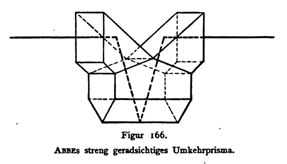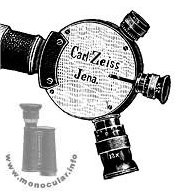
Carl Zeiss "Dosenfernrohr" - Prototyp(e)
s.jpg)
lab.jpg)
* Andrée's Polarexpedition 1896 *
| Das hier gezeigte "Dosenfernrohr" mit 3 verschiebbaren Okularen ist der Prototyp oder eine Erstanfertigung von Carl Zeiss Jena für die Polarexpedition mit einem Ballon ("Adler") des Schweden Salomon Andrée in 1896 bzw. 1897. Es befindet sich in der Polar-Ausstellung des Gränna Museums in Schweden. Das Instrument wurde bei Zeiss in der typischen geschwungenen Kursivschrift mit "Carl Zeiss Jena" mittig auf dem Prismendosendeckel und im Bogen darum mit "Andrée's Polarexpedition 1896" graviert. Die mittige Firmengravur findet sich zwar in einer Zeichnung in der Mechaniker-Zeitschrift wieder (1899; s. Bild 5), bei den späteren Serienmodellen (vgl. kleines Modell und großes Modell) befindet es sich an anderer Stelle. Dass es eine Erstkonstruktion ist, zeigen die Merkmale, die denen der Urskizze von Zeiss bereits Ende 1894 entsprechen (s. Czapski, Vortrag 4.12.1894 in: Vereinsblatt der Dt. Gesell. f. Mechanik u. Optik; No. 10, 1895). Dies sind:
|
The "Dosenfernrohr" with three moving eyepieces is the prototype or a first experimental make by Carl Zeiss Jena for the polar expedition with a balloon ("Eagle") by Swedish Salomon Andrée in 1896 and 1897 respectively. IT is now displayed in the Polar Exhibition of the Grenna Museums in Sweden. The instrument was engraved "Carl Zeiss Jena" with the characteristic cursive script (English font) on the centre of the prism box in the Zeiss workshops. The designation "Andrée's Polarexpedition 1896" is marked around this in a curve. The centred maker's marking can be found in a drawing in the magazine "Der Mechaniker" (1899; see pic. 5), but the later serial models (cf. small model and large model ) come with engravings in different spots. A proof for being a first construction type show those features which correspond with those in the prototype sketch by Zeiss at the end of 1894 already (see Czapski, speech 4.12.1894 in: "Vereinsblatt der Dt. Gesell. f. Mechanik u. Optik; No. 10, 1895). These features are:
|



boxtop.jpg)
boxbot.jpg)
| Das Dosenfernrohr (welches erst ab 1899 ab der Serienproduktion so bezeichnet wurde) ist eine erste für den zivilen Gebrauch gedachte Konstruktion mit geradsichtigem Prisma und wechselbarer Vergrößerung. Die Baugröße (40 cm lang, ca. 85mm Gehäusedurchmesser, 1kg) entspricht dem späteren kleinen Serienmodell. Zeiss wollte also zunächst ein recht leicht transportables Handfernrohr anbieten (s. Bezeichnung "Handfernrohr No. 1").
Die Konstruktion des Okularrevolvers und Tubusbefestigung wurde für die Marktreife (1899) in deren Stabilität verbessert bzw. geändert. Der Prototyp verscholl bei der gescheiterten Polarexpedition 1897 und wurde erst 1930 nach 33 Jahren im Eis auf eine Insel nahe bei Spitzbergen wieder entdeckt. Die beim Auffinden bemerkbaren Schäden und Schwachstellen (s. Fundfoto von 1930) konnten Zeiss also vorher nur durch andere Versuchsmodelle oder Ausprobieren mit dem Prototyp, der 1896 an die Expedition ging, bewusst geworden sein. Auffällig ist die erste Konstruktion des "Okularwechslers", einer bogenförmigen Platte, die sich an der Seite der Gehäusedose in Rillen bewegt, welche in die überstehenden Deckelränder eingefräst wurden. Dabei erinnert die Gehäusedose durch eine wulstigen Rand noch mehr an eine Blech- oder Konservendose als die spätere Serienversion. Diese Bauweise dürfte aber anfälliger gegenüber Verhaken in den Laufrillen oder Herausbrechen aus diesen gewesen sein als der spätere geschlossene Okularrevolverring, der komplett um die Prismendose greift. |
The "Dosenfernrohr" (which was thus named only since its serial production in 1899) is the first construction with a straight-sighted prism and changeable power for the civilian market. The design specification (40 cm long, c. 85mm diameter of the housing, 1kg) match those of the later smaller serial model. So, first Zeiss wanted to offer a rather easy to carry hand telescope (see designation "Handfernrohr No. 1").
The construction of the ocular revolver and tube attachment was changed and improved in regards to its stability when introduce on the market in 1899. The prototype got lost during the failed polar expedition in 1897 and was only found again in 1930, 33 years enclosed in ice on an island near Spitsbergen. So, Zeiss was not able to know of the damages or weak spots which were realisable after rediscovering the telescope (see photo after the discovery in 1930), and was aware of affordable necessary changes if they had other prototypes or testing the model that was handed over or sold to the expedition. The first design of the eyepiece revolver is quite striking: it is a curved plate which slides on the narrow side in grooves being milled into the protruding cover rims. The housing box resembles more a tin-can than on the later serial models because of its bulging rim. This design probably was more liable to get jammed in the grooves or to break out of the grooves than the later closed revolver ring that fully embraces the prism box. |
redisc1930c.jpg)
eyec.jpg)
obj.jpg)
| Der Prototyp wurde spätestens 1896 gefertigt oder aber bereits vorher (vgl. Czapski 1894er Zeichnung) und dann an den Expeditionsleiter S. Andrée verkauft oder abgegeben, da es als Teil der Ausrüstung für die Ballonfahrt zum Nordpol in seinem Vortrag (April 1896) erwähnt wird bzw. dabei auch neben dem so genannten Instrument(en)ring des Ballons gezeigt wurde (s. Foto u.). Fotos des Dosenfernrohrs in Benutzung während der Expedition gibt es leider nicht, obwohl viele Fotos von dem Expeditionsteilnehmer Nils Strindberg gemacht und ebenfalls 1930 wieder aufgefunden wurden. | The prototype was made in 1896 the latest or if before (cf. Czapski's drawing in 1894) it was then sold or handed over to the expedition leader S. André, because he mentions it as being a part of the equipment for the North pole balloon expedition in his speech (April 1896), and most likely also shown then next to the so-called instrument ring of the balloon (see photo below). Unfortunately, there are no photos of the revolver telescope in use during the expedition, although many photographs which were taken by the expedition member Nils Strindberg, and that were also found again in 1930. |
inst.jpg)
Dosenfernrohr auf Stativ links hinter dem Instrumentenring
Revolver Telescope on tripod on the left behind the instrument ring
(Andrées Vortrag 04/96 Andrée's speech 04/96)
redisc1930b.jpg)
Wiedergefundene Optiken 1930
rediscovered optics in 1930
expmembers.jpg)
Das Expeditionsteam 1897 The expedition team 1897
und der Ballon-Start and the start of the balloon
start.jpg)
Fotos: Zeun - Quellen & Infos: Andrée, S. A., Nils Strindberg, Knut Frænkel (1930). Med Örnen mot polen: Andrées polarexpedition år 1897; Stockholm: Bonnier.
YMER Zeitschrift der Schwedischen Gesellschaft für Anthropologie und Geographie, S. 203ff. Jg.16, YMER Magazine of the Swedish Society for Anthropology and Geography, p. 203ff., vol. 16, 1896
Bilder der Expeditions-Optiken in Gränna Pictures of the expedition optics in Grenna + online Expeditions-Bilder pictures of the expedition online + Sammlung Gränna Museum Grenne Museum collection
Eindrücke im Gränna Museum Impressions from the Grenna Museum + Dokumentationen/Filme documentary/movies: 1 - 2 - 3 Flight of the Eagle 1982 (film) - 4 Framtidens män (song)
YMER Zeitschrift der Schwedischen Gesellschaft für Anthropologie und Geographie, S. 203ff. Jg.16, YMER Magazine of the Swedish Society for Anthropology and Geography, p. 203ff., vol. 16, 1896
Bilder der Expeditions-Optiken in Gränna Pictures of the expedition optics in Grenna + online Expeditions-Bilder pictures of the expedition online + Sammlung Gränna Museum Grenne Museum collection
Eindrücke im Gränna Museum Impressions from the Grenna Museum + Dokumentationen/Filme documentary/movies: 1 - 2 - 3 Flight of the Eagle 1982 (film) - 4 Framtidens män (song)
.png)
360° Panorama APXP 1897 (Strindberg) Absturzstelle - crash site.

